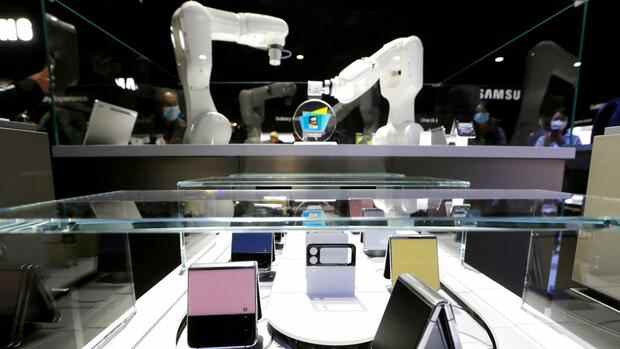The retriever is intended to help people with restricted mobility with the transport of objects in their own home.
(Photo: Screenshot Youtube)
San Francisco The models from the manufacturer Labrador Systems have little in common with the classic image of the robot. Instead of a torso with movable arms, as is the case with industrial robot manufacturer ABB, the new “retriever” is more like a movable bedside cabinet. The service robot manufacturer has now presented its latest model at the electronics trade fair CES in Las Vegas.
The simple design follows the function: the autonomously driving household robot is primarily intended for the transport of heavy objects. It should enable people with walking difficulties to move around the house more freely if they use mobility aids such as crutches and wheelchairs with their hands.
Labrador Systems itself also describes how its robots work with that of an additional pair of hands that can be operated via a smartphone or Amazon’s Alexa voice control. “There is a large proportion of our population that is massively underserved,” explains CEO Mike Dooley. His company wants to help people with restricted mobility to live more independently and more actively.
In doing so, Labrador Systems is pursuing a strategy that other manufacturers of household robots have successfully demonstrated. Instead of wanting to solve a multitude of complex tasks right from the start, the successful representatives of the industry mostly concentrate on a simple requirement.
Top jobs of the day
Find the best jobs now and
be notified by email.
The best-known example are vacuum cleaner robots: once a futuristic niche product, today, according to Bitkom data, they can be found in around every tenth German household.
In recent years, manufacturers such as Ecovacs or Roomba have gradually expanded the range of functions of their devices. Specialized home robots can now mop floors, mow the lawn and even clean windows.
The International Federation of Robotics (IFR) estimates that household robots valued at 6.7 billion US dollars were sold last year. It should be ten billion US dollars as early as 2023.
Kärcher, Vorwerk and Samsung are involved
In view of the potential, established household appliance manufacturers such as Kärcher or Vorwerk have long since entered the market. The technology group Samsung wants to take on a technological leadership role: Last year, the Korean manufacturer showed the “Bot Handy” at the CES, a prototype for a mobile robotic arm that is supposed to be able to load and unload a dishwasher, for example.
https://www.youtube.com/watch?v=m-3c9Pt3_J0
The sister model “Bot I” will follow in 2022: Instead of the greatest possible range of motion, the focus here is on communication options such as video telephony. For example, the robot should be able to be used as a device for telepresence that can be remotely controlled by the user on the other side of the line. At the same time, the robot can autonomously follow its owner through the apartment, more or less like a kind of self-driving tablet computer.
Both models are still in the research stage and will not be produced or sold in large numbers in the near future. But the group sees its prototypes as part of a long-term strategy.
Junghoe Kim, researcher at Samsung’s robotics center, said that the main focus at the moment was to develop platforms for various functions such as moving or handling objects. “Our robots should be companions.”
Hyundai shows what the distant future of robotics looks like at CES
The bravest robot vision of the CES, however, comes from the Korean technology group Hyundai, which took over the US robot manufacturer Boston Dynamics for just under a billion US dollars last summer.
The company, which now includes Boston Dynamics, plans to use robots as avatars for trips to the moon.
(Photo: AP)
In its presentation, the company showed how its robots could one day be used to guide people to distant places such as the moon thanks to telepresence, while the user himself experiences the visit through virtual reality glasses.
Compared to Labrador Systems’ mobile bedside cabinets or autonomous lawnmowers that are already available, such technologies are still years away from practical use. But Hyundai boss Chung Eui-sun was convinced in his lecture that they too will one day be a reality. “Robotics will become a horizontal link between all of our business areas,” predicts the manager.
More: Amazon surprises with the home robot Astro – a rolling tiny thing with a screen as a face
